Bringing in a feral cat isn’t quite as simple as going to your local animal shelter and picking up a kitty for adoption. If you’re considering saving a feral, there are things you need to know before opening your door.
As many of you know, I brought Alex the Fuzz in from the outdoors back in November, after he lost his mother. The Fuzz is a pretty special kitty. He practically begged to be loved and wanted to come live in the house. Not all ferals are as easy as Fuzz. Even if you do find a special cat like Alex, it’s still not a matter of saying “come on in, fella!” Let’s talk a few logistics, okay?
Saving Feral Cats: What You Need to Know Before Opening Your Door
First, let me say that I’m not a vet. All of this info is based on personal experience, research and from discussions with my own vet. I’m not an animal behavioral specialist either, so I can’t really go into a whole lot of detail about taming a feral who truly doesn’t like people. This is about that feral that does like you. The one that comes up to you during feeding time, that shows interest in being friendly with humans, that maybe even tries to snuggle up in your coat when you sit on your front steps. Alex was super willing to be loved, and that made a huge difference. We have other friendly ferals that probably wouldn’t have been so eager to be domesticated.
A vet visit is a must before even stepping foot in the house
When you adopt a kitty from a shelter, they’re already checked out and, usually, up to date on vaccines. Not so with ferals. If you have other pets, you cannot bring a feral cat into your house before you go to the vet. End of story. We have other cats and dogs, so as much as I wanted to scoop the Fuzz up right away and bring him in, I had to wait until he was cleared by a vet. He was obviously sick, with a runny nose and gunky eyes. Since my other cats are vaccinated against most kitty colds through the distemper vaccine, the vet said it was safe to bring Alex inside. She did deworm the little guy.
You may need to deal with kitty colds and other ailments
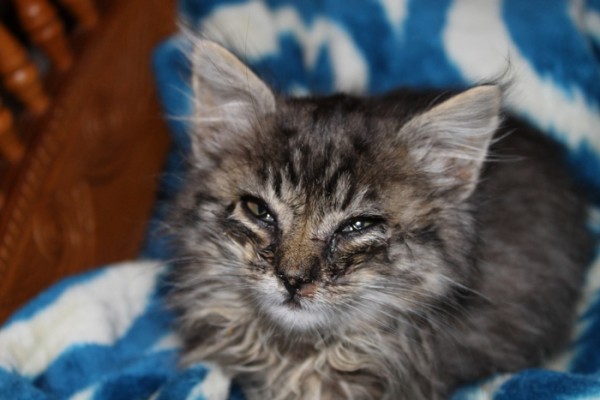
x the Fuzz right after he moved in, dealing with a kitty cold and eye infection
Alex was battling a kitty cold when we brought him inside, so we had to medicate him twice a day. We also had to put this awful cream in his eyes that he just hated. It took weeks for him to get over that cold. Before bringing in your feral, consider if you can handle the cost associated with treating infections. Fuzz has been to the vet twice for his kitty colds already. That’s a whole separate cost than his regular routine visits and shots. To make things worse, just when you think your kitty has kicked it, he starts sneezing again.
Litter box training requires more patience
Most kittens are trained by their moms to use a litter box. Your feral cat’s mom trained him to use the whole outside. Then you bring him in and say “here’s a tiny box filled with weird smelly stuff, that’s where I want you to pee.” Can you see the problem? With Alex, we used a larger yet low-sided box filled with clay litter at first, because we read something that told us to do that. Then we put it right in the middle of the office. Alex didn’t like it. He refused to use it. Every other cat in the house thought it was the most convenient thing ever, but Alex thought we were crazy.
Litter box placement is important. Your feral will likely want a private spot to do his business, so putting it in a high-traffic area wasn’t smart on our part. Once we showed him the boxes up in the cat room, he learned much faster. Our other older kitten Zoe actually helped train him by showing him how to cover up his business, so don’t discount the effect of the other cats in your house when it comes to training a feral kitten!
While Alex adjusted to regular litter pretty fast, when I was researching, I came across stories of people who actually had to use soil from outside to teach their feral how to use the litter box. Be patient and be prepared to get inventive. The good news: once it clicked with Alex, he didn’t forget.
Some ferals need space while others need constant closeness
When you bring home a feral cat, be prepared to for one of two scenarios: he’ll either vanish into a safe hideaway until he’s comfortable with you or he’ll become sticky cat. Alex was a sticky cat. He wanted to be held all the time. When he wasn’t being held, he cuddled with Zoe or his favorite dog, Maia. Even now, if I can’t find him, I just need to look for Maia. Thank goodness she’s so patient with kitties! She even bathes him! The other two dogs are tolerant, but not motherly like Maia.
Alex was used to snuggling up with his siblings and the other cats that live in the homemade feral shelters we have outside out house. He didn’t know how to be alone. He was 8 weeks when we brought him in, two weeks after his mom died. He craved companionship and love. Not all ferals will feel the same way. You need to be prepared to give them time and space. Set up a safe hideaway in a quiet location, a retreat for when they’re overwhelmed. Whether its an entire spare room just for them or a secure corner of a quiet room, they need a safe hiding spot. We made one of those t-shirt boxes for Alex that’s all over Facebook. You can see how much he loves it!
Play time takes time
One thing that really surprised me: Alex had no idea how to play. Sure, he could roll around a bit with his siblings outside, but for the most part, his life was just about surviving. He didn’t have the energy or a lot of time left over for playing. He definitely didn’t understand the concept of toys! Zoe followed him around the house, shoving toys in his path and bopping him on the head (seriously, she’d hide behind things then just “boop” him as he walked by), trying to get him to play. She was utterly disappointed when he didn’t seem to get it. Then one day, about two weeks after he came to live with us, it just clicked. Oddly, it clicked with dog toys, but hey, whatever makes the Fuzz happy.
Again, patience is key. Your feral spent most of his time just trying to live. As kittens, they do play. I’ve watched the feral kittens roll around and stalk each other, so I know they play. But as far as chasing the “red dot of death” or indulging in your rousing game of “fishing for kitties” goes, it may take time.
There are different levels of feral
One last thing before I wrap this up: all of these tips really depend on just how feral your feral is. Alex liked people, so transitioning him to a domestic life was easier. He was also really young. Some ferals require an incredible amount of patience and can take years to come around.
Alex the Fuzz really brings such incredible joy to our household. He’s truly a unique little guy, and I’m so glad we rescued him. I wish I could rescue every other feral cat still living outside my house. Our shelters are full and I just can’t bring anyone else inside right now. If you’re considering rescuing a feral, Alex says thank you!
For more articles on bringing your first pet home, visit a few of my favorite bloggers.
- Everything You Need to Bring Home Your First Hamster by Other People’s Pets
- Puppy Starter Kits for Your New Puppy by Calista’s Ramblings
- Introducing Your New Puppy to Your Older Dog by Dogurday
- 11 Things You’ll Need to Bring a New Puppy Home! by Lincoln the French
- Quick Start Guide To Bringing A New Pet Home by Time Out for Truffles
- How Pricilla Came to Live on the Farm by Broken Teepee
- Putting Together a First Aid Kit for Your New Dog by DogVills
If you have rescued a feral cat and think I missed anything, please let me know. I was trying to think of everything, but I have the flu right now, so I’m a little fuzzy (not the good kind, though, like THE Fuzz).

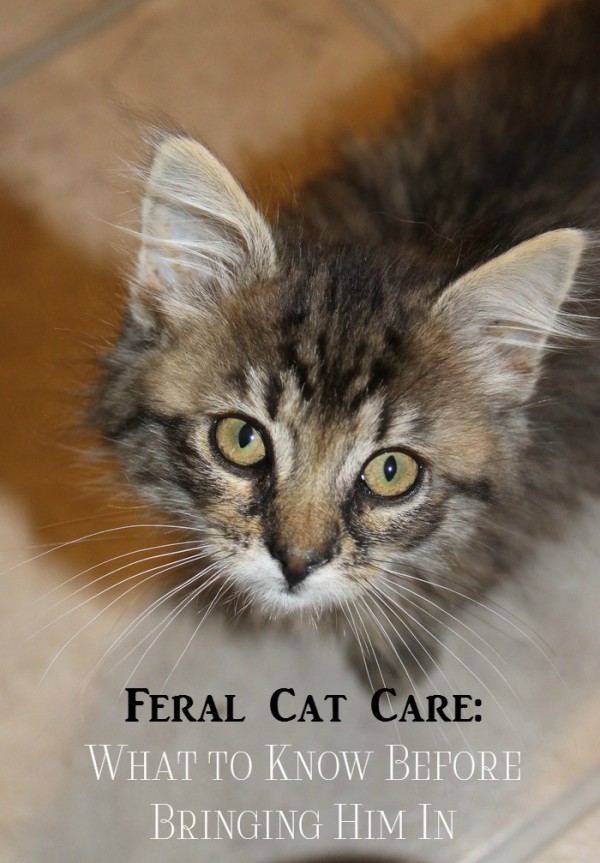
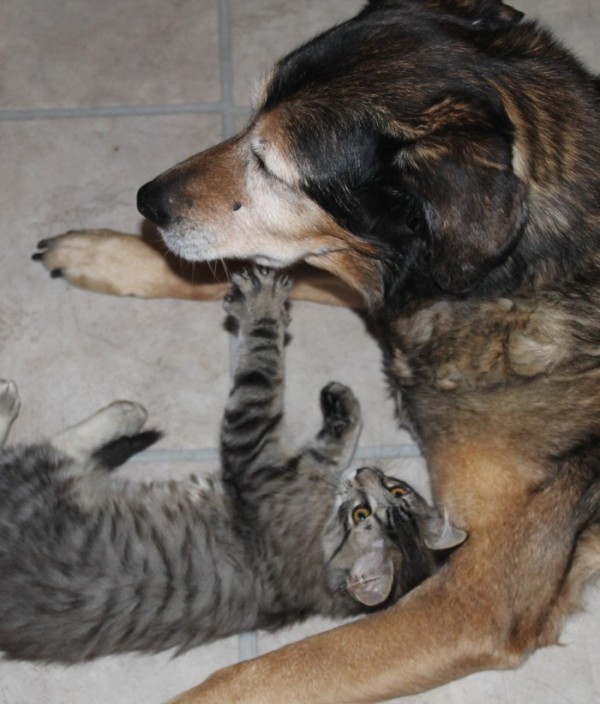
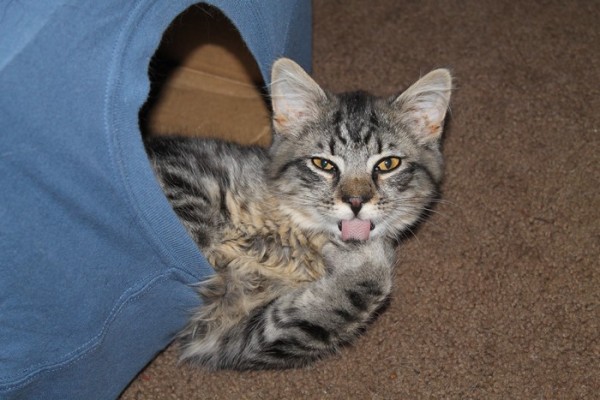
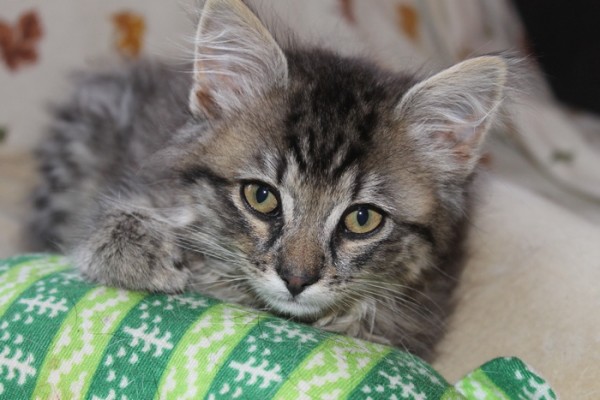


What a little cutie pie! Vet visits are so important. I always make sure ours go in regularly!
I’ve pulled in my fair share of ferals and they can be the most wonderful pets. Your tips are perfect and if someone takes the care could be rewarded with a truly loving pet.
It is important to slowly integrate feral cats into the household if you have children or other pets. Then, when they are more used to humans take them to the vet- almost all of my feral cats have had some illness or another (many lifelong ailments) from their natural habitat and other feral friends. However a domesticated feral cat is a loyal and well made family member until the end!
Jenna, did you ever deal with kitty colds? If so, how long did it take for your kitty to get over it? I’ve had cats for 20 years now, but Alex is our first feral. I’ve never dealt with a cat cold like this before. The vet isn’t concerned though because Alex still eats like a fiend, drinks plenty and has boundless kitten energy. He just sneezes a lot. Any tips would be greatly appreciated!
It takes a special person to be able to take a feral cat and give them a great home. Good for you.
I have always considered myself a dog person even though I don’t have any pets. It’s good to know what you need before taking a cute feline in though.
This is really helpful. I hope lots of people are willing to help feral cats out by finding them a safe home.
I admire you for taking in a feral cat–so many people are afraid of them.
The cat is very cute. It takes a special person to do this.
Great to know! I always want to bring in every stray cat I see, but there is so much more to deal with than just every day care.
I know someone who goes around and finds good homes for feral cats. It’s a job to be sure but she loves doing it.
how interesting and really good to know! We would love to adopt a cat but our dog hate cats…lol!
Feral cats can sometimes be tough. Great tips!
Though we don’t have pets at home, I always wanted to have couple of cute cats at home. I would definitely want to go for one in future & this might be a great resource to note.
We brought in a two year-old cat (and fed, altered, and vaccinated his mother and sister). When he came back from the vet, he never used the litter box or went anywhere in the house. After about a day, we called the vet in desperation and he told us to pick up some used newspaper from the litter box in the vet’s office and add it to our litter box. Our cat immediately caught on and – as in your experience – never forgot.
We had been playing with him outside, so learning to play wasn’t a problem, but I’ll never forget how thrilled we were when we enticed his feral mother to play for the first time, with a soft woolen ball.
Thank you for rescuing Alex. He’s a real cutie. I just want to add that people shouldn’t assume that a feral cat is too old to be adopted. Not only do cats have different personalities, but they’ve all had different experiences in their pasts. On the other hand, there are some perfectly raised non-feral kittens who are never happy or friendly!
Glad to have stumbled on this post. I have been feeding a feral for several months now. Lots of useful info. for those wondering about bringing them inside.
This is such a great article!!Thanks for sharing.
Alex The Fuzz is cute and he’s close with your dog. How adorable.